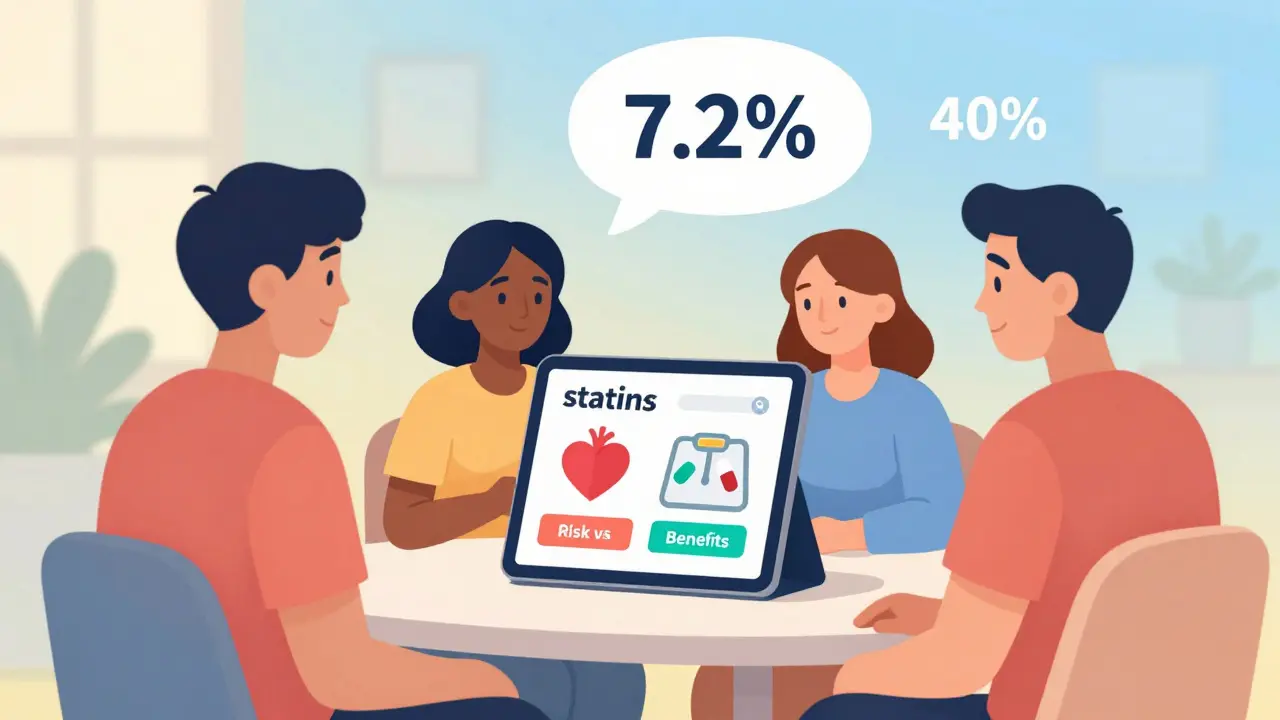Tamiflu vs. Other Flu Antivirals Comparison Tool
Tamiflu (Oseltamivir)
Class: Neuraminidase inhibitor
Route: Oral capsule or liquid
Dosage: 75 mg twice daily for 5 days
Effectiveness: ~1 day reduction
Price: $150 for 5-day course
Zanamivir (Relenza)
Class: Neuraminidase inhibitor
Route: Inhalation powder
Dosage: 10 mg twice daily for 5 days
Effectiveness: ~0.9 day reduction
Price: $180 for 5-day course
Baloxavir (Xofluza)
Class: Polymerase inhibitor
Route: Oral single dose
Dosage: 40 mg or 80 mg based on weight
Effectiveness: ~1.2 day reduction
Price: $260 for single dose
Peramivir (Rapivab)
Class: Neuraminidase inhibitor
Route: IV infusion
Dosage: 600 mg once
Effectiveness: ~1 day reduction (severe cases)
Price: $320 for single infusion
Key Decision Factors
Recommended Medication:
Quick Takeaways
- Tamiflu remains the most studied flu antiviral.
- Zanamivir (Relenza) is inhaled, making it unsuitable for people with asthma.
- Baloxavir (Xofluza) works on a different viral protein and can be a single‑dose option.
- Peramivir (Rapivab) is given intravenously for hospitalized patients.
- Cost and resistance patterns often dictate which drug is best for a given patient.
How Tamiflu (Oseltamivir) Works
When treating flu, Tamiflu (oseltamivir) is a widely prescribed neuraminidase inhibitor. The drug blocks the neuraminidase enzyme on the surface of influenza viruses, preventing newly formed viral particles from escaping infected cells. By halting spread, symptoms usually improve within 1‑2 days if the medication starts within 48hours of onset.
Key attributes of oseltamivir include:
- Oral capsule or liquid formulation.
- Standard adult dose: 75mg twice daily for five days.
- FDA approval year: 1999.
- Effectiveness: reduces illness duration by about 1day on average.

Overview of Main Alternatives
Four other antivirals have FDA approval for treating influenza. Each belongs to a different class or delivery method, which creates practical trade‑offs.
Zanamivir, marketed as Relenza, is also a neuraminidase inhibitor but is inhaled as a powder. It’s useful for people who can’t swallow pills, yet it triggers bronchospasm in up to 10% of asthmatic patients.
Baloxavir marboxil (Xofluza) targets the viral polymerase acidic (PA) protein, a mechanism distinct from neuraminidase blockers. A single oral dose (40mg or 80mg based on weight) can finish treatment, which appeals to patients who dislike multi‑day regimens.
Peramivir, sold as Rapivab, is an intravenous neuraminidase inhibitor. It’s reserved for hospitalized or severely ill patients who cannot take oral or inhaled meds.
Finally, Influenza virus itself mutates quickly. Resistance to neuraminidase inhibitors has been documented, especially after widespread oseltamivir use, prompting clinicians to consider alternatives when resistant strains circulate.
Head‑to‑Head Comparison
| Attribute | Tamiflu (Oseltamivir) | Zanamivir (Relenza) | Baloxavir (Xofluza) | Peramivir (Rapivab) |
|---|---|---|---|---|
| Drug class | Neuraminidase inhibitor | Neuraminidase inhibitor | Polymerase inhibitor | Neuraminidase inhibitor |
| Administration route | Oral capsule or liquid | Inhalation powder | Oral single dose | IV infusion |
| Typical regimen | 75mg BID × 5days | 10mg BID × 5days | One dose (40mg ≤80kg, 80mg >80kg) | 600mg once (single IV infusion) |
| FDA approval year | 1999 | 1999 | 2018 | 2014 |
| Symptom reduction (average) | ~1day | ~0.9day | ~1.2day | ~1day (severe cases) |
| Common side effects | Nausea, vomiting | Cough, bronchospasm | Diarrhea, headache | Infusion site pain, nausea |
| Average wholesale price (US, 2025) | $150for 5‑day course | $180for 5‑day course | $260single dose | $320single infusion |
| Resistance reports (last 5years) | Low to moderate | Low | Rare | Very low |
When to Choose Tamiflu vs. Alternatives
Decision‑making hinges on three practical factors: patient condition, administration feasibility, and local resistance patterns.
- Early, uncomplicated flu in adults: Tamiflu and zanamivir have comparable efficacy. If the patient has swallowing difficulties but no asthma, zanamivir (inhaled) works well. Otherwise, the oral convenience of Tamiflu usually wins.
- Pediatric cases (≥1year): FDA approves Tamiflu for children as young as 2weeks (dose based on weight). Zanamivir is only for ≥5years. Baloxavir is approved for ≥12years, so Tamiflu remains the go‑to for younger kids.
- Severe or hospitalized illness: IV peramivir delivers rapid plasma levels when oral intake is impossible. Tamiflu can be given via nasogastric tube, but peramivir avoids absorption concerns.
- Single‑dose preference: Baloxavir’s one‑time oral dose appeals to busy adults who might miss multi‑day regimens. However, insurance coverage for Baloxavir is still catching up, which can raise out‑of‑pocket costs.
- Known neuraminidase‑resistant strain: If local surveillance reports high oseltamivir resistance, switching to baloxavir (different mechanism) or IV peramivir is prudent.
Ultimately, clinicians weigh these scenarios against patient allergies, pregnancy status, and drug‑interaction profiles.
Resistance & Safety Considerations
Resistance emerges when the viral neuraminidase gene mutates, reducing drug binding. Surveillance from the CDC shows oseltamivir‑resistant strains accounted for 1‑2% of isolates in 2023‑2024, up from <1% a decade earlier. Zanamivir shares the same target, so cross‑resistance can occur. Baloxavir’s polymerase inhibition sidesteps this issue, making it a useful backup.
Safety warnings:
- Tamiflu: nausea, vomiting, rare neuropsychiatric events in children.
- Zanamivir: bronchospasm, cough; contraindicated in severe asthma.
- Baloxavir: diarrhea, possible liver enzyme elevations.
- Peramivir: infusion‑related reactions, rare renal toxicity.
Pregnant patients can safely use oseltamivir, backed by WHO guidance, while data for baloxavir in pregnancy remain limited.
Cost, Access, and Insurance Tips
Price varies widely. Tamiflu’s generic version dropped to roughly $30 per 5‑day adult course in 2025, but brand‑name pricing still appears on many pharmacy lists. When prescribing, ask the pharmacy about the generic option; most insurers cover it with a modest copay.
Baloxavir, being newer, stays at the higher single‑dose price. Some health plans place it in a higher tier, requiring prior authorization. Peramivir is typically administered in a hospital setting, so its cost is bundled into inpatient charges.
Practical steps to keep out‑of‑pocket costs low:
- Check the drug’s generic availability before filling.
- Use discount cards or pharmacy savings programs for brand‑name Tamiflu if generic isn’t stocked.
- Ask the prescriber if a 5‑day supply can be split into two 2‑day bottles to reduce waste when treatment starts late.
- When possible, request a “therapeutic interchange” - a pharmacy may substitute a cheaper neuraminidase inhibitor if the prescriber allows it.
Frequently Asked Questions
Can I take Tamiflu if I’m pregnant?
Yes. Health authorities, including WHO and CDC, consider oseltamivir safe during pregnancy because benefits of treating flu outweigh potential risks.
How soon after symptoms start should I begin antiviral therapy?
The earlier, the better. Starting within 48hours of fever or respiratory symptoms gives the biggest reduction in illness duration.
Is baloxavir effective against oseltamivir‑resistant strains?
Yes. Because baloxavir targets a different viral protein (polymerase), it retains activity against most neuraminidase‑resistant viruses.
Can children under 5 use zanamivir?
No. Zanamivir is approved for children 5years and older due to inhalation technique requirements.
What should I do if I miss a dose of Tamiflu?
Take the missed dose as soon as you remember, unless it’s almost time for the next dose. Don’t double up; just continue the regular schedule.







Tom Saa
October 7, 2025 AT 03:20When one surveys the landscape of influenza therapeutics, the calculus often reduces to a triad: pharmacokinetic convenience, resistance profile, and economic burden. In practice, the decision matrix tilts toward agents that balance early administration with a tolerable side‑effect spectrum. Tamiflu satisfies that equilibrium for the majority of uncomplicated cases, yet clinicians must remain vigilant for emerging neuraminidase mutations.
Jessica H.
October 7, 2025 AT 17:13The comparative table presents a clear hierarchy of convenience, yet it neglects the nuanced pharmacovigilance data that distinguish oseltamivir from its peers. While the cost differential appears modest, the long‑term implications of resistance demand a more rigorous evaluation than the surface‑level metrics offered.
John Magnus
October 8, 2025 AT 07:06The enzymatic inhibition of neuraminidase by oseltamivir is mediated through a competitive binding mechanism that mimics the sialic acid transition state.
The kinetic studies have demonstrated a Ki value in the low nanomolar range, conferring high affinity for the active site.
Pharmacodynamically, this results in a reduction of virion egress from infected epithelial cells, thereby truncating the viral replication cycle.
Clinical trials consistently report a median reduction of illness duration by approximately one calendar day when therapy commences within 48 hours of symptom onset.
In contrast, zanamivir’s inhalational delivery imposes a particle‑size dependent deposition profile that can exacerbate bronchospasm in asthmatic cohorts.
Baloxavir’s cap‑dependent endonuclease inhibition represents a mechanistically distinct approach, with a single‑dose regimen that may improve adherence metrics.
However, the pharmacoeconomic analysis reveals a wholesale acquisition cost exceeding $250 per course, challenging formulary inclusion in resource‑constrained settings.
Peramivir, administered intravenously, achieves peak plasma concentrations rapidly, a salient advantage for hospitalized patients unable to tolerate enteral routes.
The adverse event spectrum for oseltamivir is dominated by gastrointestinal disturbances, notably nausea and emesis, which are generally self‑limiting.
Resistance monitoring via the CDC’s FluSurv‑Net indicates a low‑to‑moderate prevalence of H275Y mutations, mandating judicious prescription practices.
From a stewardship perspective, the selection of a neuraminidase inhibitor should incorporate local resistance trends, patient comorbidities, and drug‑drug interaction profiles.
The oral bioavailability of oseltamivir exceeds 80 %, facilitating outpatient management without the need for specialized delivery devices.
Moreover, weight‑based dosing adjustments in pediatrics have been validated, rendering oseltamivir the only antiviral with FDA approval for infants as young as two weeks.
Economic modeling suggests that, despite its modest price point, the indirect cost savings from reduced work absenteeism can offset the drug expense in high‑incidence seasons.
Ultimately, the therapeutic algorithm must balance efficacy, safety, administration logistics, and institutional budgetary constraints to optimize patient outcomes.
angelica maria villadiego españa
October 8, 2025 AT 21:00I understand how overwhelming the drug choices can feel, especially when you’re trying to get back on your feet quickly. The oral option of Tamiflu often works well for most adults, and it’s easier to take than an inhaled powder if you have any breathing issues.
Ted Whiteman
October 9, 2025 AT 10:53Everyone keeps shouting that Tamiflu is the gold standard, but let’s be honest-it’s just a trendy excuse to keep pharma profits soaring. If you look at the marginal one‑day benefit, you’d think we’re paying for a placebo with a fancy label. The single‑dose wonder, Baloxavir, actually steals the spotlight, yet the insurance companies act like it’s a myth.
Snehal Suhane
October 10, 2025 AT 00:46Oh really, another “comprehensive” guide that pretends to be unbiased. It’s like they spent weeks polishing a brochure while ignoring the real cost-your wallet. If you ask me, the whole thing is a marketing gimmick cloaked in science‑talk. Get over it.
Ernie Rogers
October 10, 2025 AT 14:40Tamiflu is just a cash grab
Eunice Suess
October 11, 2025 AT 04:33i cant believe they're still using “its” when they mean “it's”-the grammar police are on a break here and it’s a total disaster each time they drop a typo like that i guess they think it's fine but it's not
Anoop Choradia
October 11, 2025 AT 18:26One must consider the broader pharmaco‑economic orchestration that underpins the promotion of neuraminidase inhibitors. The selective funding of oseltamivir, juxtaposed with the marginalization of polymerase inhibitors, raises questions about the influence of vested interests within regulatory corridors. It is conceivable that strategic alliances between manufacturers and advisory panels have subtly steered clinical guidelines toward familiar, high‑volume agents, thereby perpetuating a controlled market dynamic.
Michael Weber
October 12, 2025 AT 08:20While your exhaustive enumeration of pharmacologic details is impressive, it borders on an academic exercise that overlooks the human element of patient experience. The relentless focus on numbers can feel like an emotional vacuum, draining the very compassion that should accompany therapeutic decisions. In the end, the clinician’s wisdom lies not merely in data aggregation but in the empathetic translation of that data to bedside care.
Leslie Woods
October 12, 2025 AT 22:13i see what you mean about the resistance data and i think it’s a solid point we should dig deeper into those studies
bhavani pitta
October 13, 2025 AT 12:06In contrast to the sardonic tone presented, one might argue that the guide offers a balanced overview, albeit succinct. The assertion that it is a mere marketing ploy neglects the underlying evidence base that supports each antiviral’s clinical utility, thereby diminishing the discourse.
Blake Marshall
October 14, 2025 AT 02:00actually tamiflu’s cost is low compared to baloxavir but you gotta consider the whole treatment cycle not just the pill price
Manish Singh
October 14, 2025 AT 15:53i totally get how confusing it can be especially when you’re feeling sick its hard to think straight so i think the best way is to talk to your doc and they can help pick the right med for you
Shana Shapiro '19
October 15, 2025 AT 05:46Your passionate critique highlights a valid frustration; however, the modest benefit of Tamiflu should not be dismissed outright, as many patients find relief in that incremental improvement, which can be life‑changing during severe flu seasons.